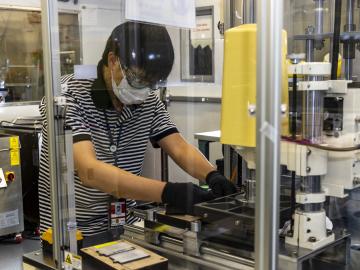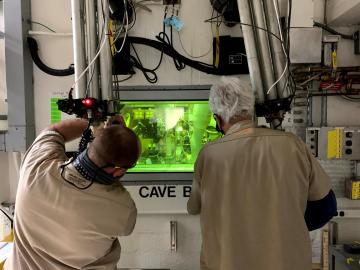
Filter News
Area of Research
- Advanced Manufacturing (10)
- Biology and Environment (10)
- Energy Science (74)
- Fusion and Fission (5)
- Isotopes (14)
- Materials (25)
- Materials for Computing (16)
- National Security (12)
- Neutron Science (11)
- Nuclear Science and Technology (8)
- Quantum information Science (2)
- Supercomputing (15)
- Transportation Systems (1)
News Topics
- (-) 3-D Printing/Advanced Manufacturing (54)
- (-) Biotechnology (7)
- (-) Cybersecurity (9)
- (-) Isotopes (20)
- (-) Microscopy (18)
- (-) National Security (9)
- (-) Polymers (12)
- (-) Security (6)
- (-) Space Exploration (6)
- (-) Transportation (36)
- Advanced Reactors (16)
- Artificial Intelligence (15)
- Big Data (16)
- Bioenergy (26)
- Biology (28)
- Biomedical (32)
- Buildings (14)
- Chemical Sciences (12)
- Clean Water (10)
- Composites (7)
- Computer Science (69)
- Coronavirus (35)
- Critical Materials (6)
- Energy Storage (42)
- Environment (68)
- Exascale Computing (5)
- Frontier (5)
- Fusion (21)
- Grid (17)
- High-Performance Computing (22)
- ITER (4)
- Machine Learning (9)
- Materials (34)
- Materials Science (59)
- Mathematics (3)
- Mercury (4)
- Molten Salt (2)
- Nanotechnology (27)
- Neutron Science (55)
- Nuclear Energy (37)
- Physics (16)
- Quantum Computing (5)
- Quantum Science (26)
- Statistics (1)
- Summit (26)
Media Contacts

At the Department of Energy’s Oak Ridge National Laboratory, scientists use artificial intelligence, or AI, to accelerate the discovery and development of materials for energy and information technologies.

In his career focused on energy storage science, Jianlin Li has learned that discovering new ways to process and assemble batteries is just as important as the development of new materials.

Through a consortium of Department of Energy national laboratories, ORNL scientists are applying their expertise to provide solutions that enable the commercialization of emission-free hydrogen fuel cell technology for heavy-duty

When COVID-19 was declared a pandemic in March 2020, Oak Ridge National Laboratory’s Parans Paranthaman suddenly found himself working from home like millions of others.

Oak Ridge National Laboratory scientists proved molybdenum titanium carbide, a refractory metal alloy that can withstand extreme temperature environments, can also be crack free and dense when produced with electron beam powder bed fusion.

A newly released dataset that tracks the movement of everything from food to gasoline across the United States by air, water, truck, rail and pipeline showed the value and tonnage of those goods rose significantly between 2012 and 2017.

A rare isotope in high demand for treating cancer is now more available to pharmaceutical companies developing and testing new drugs.

Scientists at Oak Ridge National Laboratory successfully demonstrated a technique to heal dendrites that formed in a solid electrolyte, resolving an issue that can hamper the performance of high energy-density, solid-state batteries.

Oak Ridge National Laboratory researchers combined additive manufacturing with conventional compression molding to produce high-performance thermoplastic composites reinforced with short carbon fibers.

A new method developed at Oak Ridge National Laboratory proves one effort’s trash is another’s valuable isotope. One of the byproducts of the lab’s national plutonium-238 production program is promethium-147, a rare isotope used in nuclear batteries and to measure the thickness of materials.


